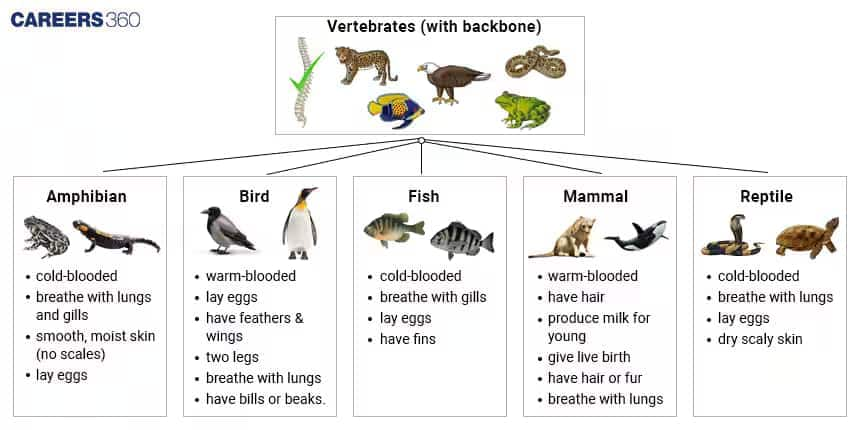Vertebrates: Definition, Meaning, Characteristics, Classifications, Examples
Vertebrates are animals in the subphylum Vertebrata, characterised by a backbone or spinal column. The meaning of vertebrates lies in their defining feature, i.e., the vertebral column, which is found internally to support their body. Vertebrate classes include fish, amphibians, reptiles, birds, and mammals, each with unique general characteristics of vertebrates like a notochord and a dorsal nerve cord. This is an important part of the chapter Animal Kingdom Biology.
This Story also Contains
- What are Vertebrates?
- Characteristics of Vertebrates
- Classification of Vertebrates
- Examples of Different Vertebrates
- Recommended Video for Vertebrates
.jpg)
The evolution of vertebrates made a huge impact on the diversity of animals on Earth starting from simple vertebrate ancestors in water to complex features like jaws, lungs for respiration. Most of the animals fall in this category. The diversity move from aquatic to terrestrial animals brought great changes in the structures, functions, and behavior of the diversity of life today in Animal Kingdom.
What are Vertebrates?
Vertebrates are animals that belong to the subphylum Vertebrata. They feature a backbone or spinal cord that is part of an internal skeleton that provides basic support to their body and lets complex movement take place. Vertebrates are one of the most advanced organisms on Earth, and they vary greatly from fish to mammals.
They are distributed all over the globe, from the deepest oceans to the highest mountains. These vertebrates play a very important role in maintaining the balance of the ecosystems and Biodiversity.
General characteristics of vertebrates, the classification of the vertebrates, and examples of vertebrate animals are highly important when studying ecology and evolution. Vertebrates can also be categorized into distinct classes of vertebrates that each boast different characteristics.
Also Read:
Characteristics of Vertebrates
General characteristics of vertebrates help define this group and are important in vertebrate classification. Vertebrates include fish, amphibians, reptiles, birds, and mammals. These vertebrate characteristics are vital to the study of vertebrate animals and their evolutionary development. Several key anatomical and physiological features distinguish vertebrates. These are:
Notochord: The notochord is a flexible, rod-shaped body structure found in all vertebrate embryos. It gives mechanical support and forms the backbone, or vertebral column, of a vertebrate.
Dorsal Hollow Nerve Cord: It is a unique feature in vertebrates. It develops into the brain and spinal cord to form the central nervous system of the vertebrate.
Pharyngeal Slits: These are the openings present in the pharynx of all the vertebrates at some point in their development. They develop into gills in aquatic animals and into different structures of the head and neck in terrestrial animals.
Post-anal Tail: In most vertebrates, there exists a tail behind the anus that provides balance and helps in locomotion, among many other functions.
Classification of Vertebrates

Vertebrates are classified according to their anatomical, physiological, and genetic characteristics, besides their evolutionary relationships. This classification shows vertebrate animals are diverse and that their general characteristics range in anything from a fish to a mammal. There are the following major classes of vertebrates:
Agnatha: These vertebrate animals do not possess jaws, paired fins, and scales, and a cartilage-based skeleton is present. For example, Lampreys and hagfish.
Chondrichthyes: These have a skeleton made of cartilage and placoid scales.For example, Sharks and rays.
Osteichthyes: Vertebrates classified under this class are covered in bony skeletons and sport an operculum which comes over the gills.For example Salmon and goldfish.
Amphibia: Vertebrates in this class have dual life stages, such as aquatic larvae and terrestrial adults and permeable skin.For example Frogs and salamanders.
Reptilia: These vertebrates have dry, scaly skin and lay amniotic eggs.For example, Snakes and lizards.
Aves: Vertebrates classified as birds have features that include feathers, beaks, and light skeletons.For example Eagles and sparrows.
Mammalia: Mammals have hair or fur, mammary glands, and are endothermic or warm-blooded.For example, humans and whales.
Examples of Different Vertebrates
Vertebrates are animals with a backbone and are divided into different classes based on their features. Common examples of vertebrates include:
Agnatha: Petromyzon (lamprey), Myxine (Hagfish)
Chondrichthyes (Cartilaginous Fishes): Scoliodon (Dogfish), Carcharodon (Great White Shark), Trygon (Stingray)
Osteichthyes (Bony Fishes): Labeo (Rohu), Catla, Clarias (Magur)
Amphibia (Amphibians): Frog, Salamander, Toad
Reptilia (Reptiles): Snake, Lizard, Crocodile
Aves (Birds): Eagle, Sparrow, Penguin
Mammalia (Mammals): Human, Elephant, Dolphin

Also Read:
Recommended Video for Vertebrates
Frequently Asked Questions (FAQs)
Vertebrates are animals in the subphylum Vertebrata, characterised by a backbone or spinal column. The meaning of vertebrates lies in their defining feature, i.e., the vertebral column, which is found internally to support their body.
Vertebrates are said to have a notochord, a dorsal hollow nerve cord, pharyngeal slits, a post-anal tail, and an endoskeleton.
Vertebrates are further divided into a series of classes which include the Agnatha, Chondrichthyes, Osteichthyes, Amphibia, Reptilia, Aves, and Mammalia.
Vertebrates play various key roles within the ecosystem as predators, food, and animals that maintain the day and night equilibrium. They are also significant in nutrient cycling and habitat creation.
Vertebrates reproduce through various methods including oviparous (egg-laying), ovoviviparous (eggs hatch inside the body), and viviparous (live birth).